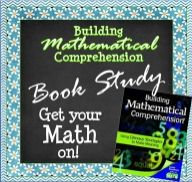Finally back for more of Building Mathematical Comprehension by Laney Sammons.

I don't know what happened to me the last week and half or two, but I just lost my focus and momentum there for a bit. Good to be back to it!
So now that I'm thoroughly behind I'll cover chapters 5 and 6 in this post and we'll hit chapter 7 in the next one. Hopefully I'll be caught up here soon.
You can check out my previous posts with the links below.
As I've been reading I was starting to see a recurring theme. Once Sammons lays the foundation for the chapter she applies it to the classroom by giving the following information:
- how to teach the strategy through modeling and think alouds
- various activities and/or instructional methods for applying the strategy
- ideas for Math Stretches that apply to the strategy
- how to use children's literature to apply the strategy
It seems Sammons uses this same outline for each chapter. Just to help myself get caught up here, I'm going to just pick out a few things from chapters 4 and 5 that really stood out to me.
Chapter 5- Visualization
Visualization requires students to use not only decoding skills, but schema as well. Without valuable prior experiences, students may struggle with visualizing. It must be taught and practiced. (147) Creating these mental images helps students tie their new learning with information or experiences that are already familiar to them. (148)
One huge roadblock to visualization in our day in age is the fact that students are so immersed in visuals (television, video games, iPod, Pads, and Phones...) that they don't generally have to put forth any effort to create visuals, they're all just provided. (147)
Ok, that's it. I'm cutting TV time at home. I've been way too lax this summer. Poor "movie making" baby brains.
What do our students need to know about visualization?
1. They can use visualization intentionally (148)
2. Not understanding a new concepts is ok...there are ways to work around being afraid of "not knowing" (148)
3. Engagement increases when visualization is used (149)
4. It's ok to have to change previous visualizations or ideas about a topic as you learn more information (149)
5. It's important to share your ideas with others (149)
Even though students visualize subconsciously all the time, we need to teach them how to do it intentionally. Here's how:
- First have students create a visualization of something concrete. You can do this by pairing students and having one student describe a picture, while the other visualizes it. Then they visualizer can check to see how accurate they were.
- Next, have students describe something they've see before but that they cannot currently see. This is a beneficial retrieval exercise.
- Then you'll want to have students do another visualization of something that is very familiar, like their bedroom or another room in their home. Have students illustrate and share.
- Add motion next. Help students extend visualization by not only describing a snapshot of an object or thing, but now visualize an event. For example, have students visualize themselves running a race and making it through to the finish line. They should be able to "see" the event happening in their mind.
- As student improve their intentional visualization, you can also ask students to create visual images based on details for a story being read in class. Help students to compare and contrast their visualizaitons.
- Students are now ready to examine illustrations to see various representations of text or mathematical concepts. At this point we want to help students create a nice mental "bank" of various representations for the same concept.
- Finally, students are ready to independently create mental pictures. Be sure to remind them to use these visualization skills when tackling new math problems or concepts.
(153-155)
Chapter 6: Making Inferences and Predictions
Inferring is the foundation for comprehension in reading and mathematics. Comprehension suffers when students are unable to make quality inferrences. (171)
Inferring is an inductive process, meaning students students start with all the little bits of prior knowledge and blend that with new information to create meaning. Again, we see the schema connection and its importance. (172)
Here are some important things to note concerning inferring and predicting:
- Give time for students to share inferences and predictions. This is how students can reconcile conflicts between schema and new information. (175)
- Ask questions like, "What would happen if..." and allow students to make predictions (175)
- Predictions can be confirmed or contradicted. Show students how to use evidence to do this. (176)
- Examine inferences as a class to determine the value of the inference. Not every inference has value to the task at hand. (176)
Here are some activities for teaching inferring and predicting.
WORD SPLASH- Write a bunch of words on the board that are related to a math topic. Students have to predict what the topic will be. (186)
INFERENCE AND EVIDENCE CHART- Hold students accountable for making fact based inferences by using a two column chart. On one side record inferences and on the other side record the evidence for that inference. (187)
WHAT'S THE QUESTION STRETCH- Post a short story (6-8 sentences) that includes math related facts. Have students predict what questions could be asked using those facts. Students will have to infer some things about the scenario and predict what could have been asked using those facts.
FACT OR INFERENCES? STRETCH- Students read a story scenario. On a chart there are statements either from the story or that have been inferred from the story. Students have to decide which is which.
I predict I'll be seeing you soon for Chapter 7......hahaha!

Learning exercises like this are very helpful. It will keep students' brains working. As they say, practice makes perfect. Even a university student would love this...
ReplyDelete